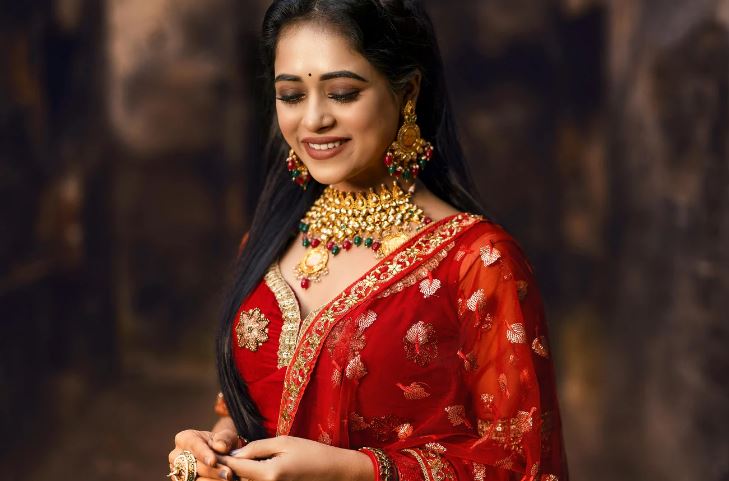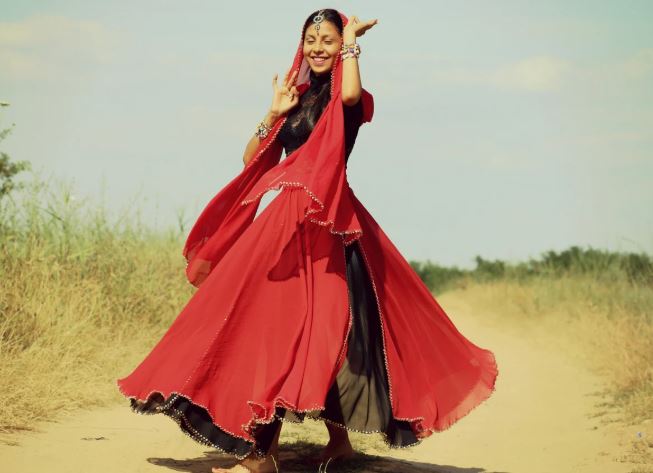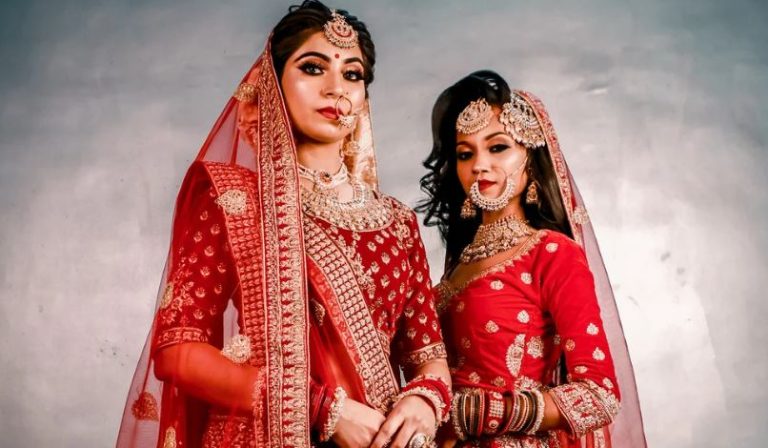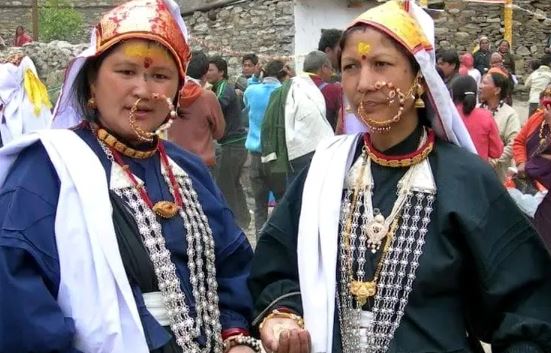Assam, a state known for its rich cultural heritage and natural beauty, boasts a vibrant tradition of clothing that reflects the essence of its people. The top 10 Assamese traditional dresses are not only beautifully crafted but also embody the region’s deep-rooted values, history, and craftsmanship.
These garments, made from luxurious silks such as Muga, Pat, and Eri, showcase intricate designs and symbolic motifs inspired by nature. From weddings to festivals, traditional Assamese attire plays a significant role in marking cultural milestones.
In this article, we explore the finest traditional dress options from Assam that continue to be cherished and celebrated for their timeless beauty and cultural significance.
What Materials Are Commonly Used in Traditional Assamese Attire?
Traditional Assamese attire is predominantly crafted from natural fibres, with Muga silk, Pat silk, and Eri silk being the most prized materials. Muga silk, known for its golden hue, is native to Assam and symbolizes luxury and craftsmanship.
Pat silk, lighter in texture, is often used for more formal occasions, while Eri silk, also known as “peace silk,” is sustainable and comfortable.
Cotton fabrics are also used for everyday wear, especially in warmer weather. These materials not only contribute to the elegance of the garments but also hold cultural and historical significance in Assam.
How Do Assamese Clothing Designs Reflect Cultural Significance?
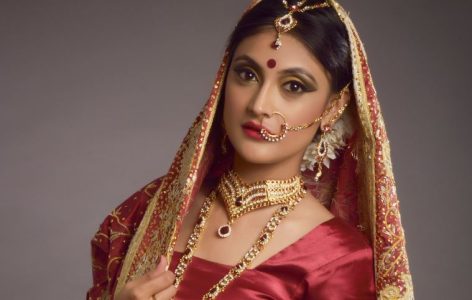
The designs and patterns of Assamese clothing are deeply rooted in the region’s natural surroundings and cultural heritage.
Motifs inspired by flora, fauna, and geometric shapes are common, symbolizing the connection between the people and nature.
These designs are often woven using intricate handloom techniques that have been passed down for generations, reflecting Assam’s rich artisanal traditions. The clothing is also imbued with symbolic meaning, representing fertility, prosperity, and spirituality.
When Is Traditional Assamese Clothing Worn During the Year?
Traditional Assamese clothing is worn during various festivals, weddings, and cultural events, with special significance attached to occasions like Bihu, the most celebrated festival in Assam.
During Bihu, Assamese people wear their traditional garments as a way of honoring their cultural identity and heritage.
Additionally, clothing is worn during community gatherings, rituals, and ceremonial functions, making it an integral part of Assamese social life throughout the year.
What Motifs and Patterns Are Prominent in Assamese Traditional Garments?
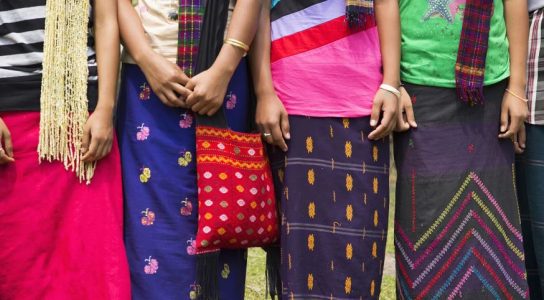
Traditional Assamese garments often feature motifs inspired by nature, such as flowers, creepers, birds, and geometric shapes.
These designs are not only decorative but also symbolize the region’s agricultural life, spiritual beliefs, and connection to the environment.
Each motif holds specific meanings, such as prosperity, growth, and fertility, and is woven meticulously by artisans, making every garment a reflection of the Assamese ethos and creativity.
How Does Traditional Assamese Dress Symbolize Identity and Pride?
Traditional Assamese attire is a powerful expression of cultural pride and identity. The garments, made from indigenous silk and adorned with meaningful motifs, symbolize the region’s historical legacy and the craftsmanship of its people.
Wearing traditional dress during major festivals or weddings reinforces the Assamese sense of community and heritage, serving as a reminder of the enduring traditions passed down through generations.
These garments are a reflection of Assamese values, such as respect for nature and cultural preservation, making them a source of immense pride.
Top 10 Assamese Traditional Dress
1. Mekhela Chador
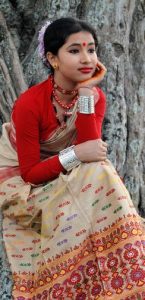
Image – Source
Mekhela Chador is the most iconic traditional dress in Assam, epitomizing elegance and cultural heritage. It consists of two pieces the Mekhela, a cylindrical skirt, and the Chador, a draped cloth for the upper body.
Usually made of Assam’s prized Muga or Pat silk, this attire is celebrated for its unique weaving techniques and patterns inspired by nature, like flowers, creepers, and geometric shapes.
The Mekhela Chador stands out due to its silk texture and elaborate motifs, which are woven using handloom techniques passed down through generations.
It is particularly popular during Bihu and weddings, where it symbolizes Assamese identity and pride. The artistry of Mekhela Chador is now recognized globally, showcasing Assam’s remarkable craftsmanship.
This attire also includes specific accessories like the Gam Kharu bracelet, adding elegance to the ensemble. The traditional Mekhela Chador continues to hold a special place in Assamese culture, blending heritage with timeless beauty.
| Aspect | Details |
| Material | Muga, Pat, and Eri silk |
| Key Features | Two-piece garment (Mekhela as skirt and Chador as wrap) |
| Occasions | Weddings, festivals, and formal events |
| Special Motifs | Nature-inspired designs, including floral and geometric patterns |
| Significance | Represents Assamese identity and cultural pride |
2. Gamusa

Image – Source
Gamusa is more than just a piece of cloth in Assam; it is a symbol of honour, respect, and Assamese culture. This rectangular cotton fabric, often featuring a red border and decorative patterns, is worn as a scarf, headgear, or adornment for religious ceremonies and festivals, particularly during Bihu.
The red and white colours of Gamusa hold a special meaning, symbolizing purity, integrity, and Assamese pride. During special occasions, Gamusa is presented to guests and elders as a mark of respect, showcasing Assamese hospitality. Its utility in daily life and ceremonies makes it indispensable in Assamese culture.
In addition to its symbolic use, Gamusa is functional, serving as a towel or protective head wrap. Handwoven by artisans, Gamusa has gained significance worldwide, serving as an emblem of Assamese culture.
| Aspect | Details |
| Material | Primarily cotton, with some silk versions |
| Key Features | Rectangular cloth with a red border and intricate designs |
| Occasions | Used during Bihu, cultural events, and for daily use |
| Special Motifs | Geometric or floral patterns |
| Significance | Represents Assamese identity, respect, and cultural pride |
3. Dokhona
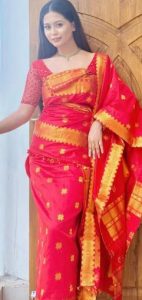
Image – Source
The Dokhona is the signature garment of the Bodo women in Assam, representing a blend of vibrant colours, rich patterns, and Bodo culture. This single-piece garment is wrapped around the body, with the Agor belt adding a decorative touch to the outfit. The Dokhona is woven from cotton, although silk versions are worn on special occasions.
The patterns on the Dokhona are significant, as they often reflect Bodo symbolism, including natural motifs and geometric designs. The Bodo women wear it with pride, showcasing their rich tribal heritage, especially during festivals and cultural events.
Today, the Dokhona is gaining popularity beyond the Bodo tribe, symbolizing Assam’s diversity. Its craftsmanship and unique patterns make it a beloved garment, celebrated for its distinct style and cultural relevance.
| Aspect | Details |
| Material | Primarily cotton, with some silk for formal occasions |
| Key Features | Single-piece wrap-around garment |
| Occasions | Worn during Bodo festivals, weddings, and everyday life |
| Special Motifs | Tribal symbols, natural elements, and geometric patterns |
| Significance | Embodies the cultural identity of the Bodo tribe |
4. Riha-Mekhela
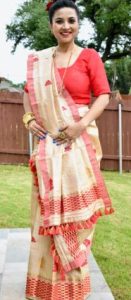
Image – Source
The Riha-Mekhela is another traditional dress for Assamese women, worn especially by young girls during festivals, ceremonies, and pre-wedding events. It comprises the Riha (an inner wrap) and Mekhela (a skirt), with a Chador draped over the shoulders. This attire is typically crafted from Eri or Pat silk, showcasing fine craftsmanship and intricate designs.
Riha-Mekhela is known for its colourful embroidery and woven patterns inspired by Assamese flora and fauna. The attire holds a place of honour during religious ceremonies and has deep-rooted significance in Assamese customs.
Rich in cultural value, the Riha-Mekhela is a symbol of Assamese tradition, reflecting the cultural artistry of handloom weaving.
| Aspect | Details |
| Material | Eri, Pat, and sometimes cotton |
| Key Features | Inner wrap (Riha), skirt (Mekhela), and draped cloth (Chador) |
| Occasions | Festivals, religious ceremonies, and weddings |
| Special Motifs | Traditional floral and faunal patterns |
| Significance | Symbolizes Assamese tradition and cultural heritage |
5. Chadar-Mekhela
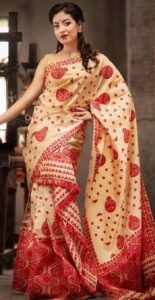
Image – Source
The Mishing tribe of Assam has its unique attire known as the Chadar-Mekhela, resembling the Mekhela Chador but with distinct tribal patterns and designs. The attire is made of cotton or Eri silk, showcasing motifs that represent Mishing heritage, including geometric and animal designs.
Chadar-Mekhela holds a cultural essence, especially worn during festivals and special events. Its earthy colours and traditional patterns represent the Mishing people’s bond with nature and their agricultural lifestyle.
This traditional outfit adds to Assam’s rich cultural diversity, representing the unique identity of the Mishing community.
| Aspect | Details |
| Material | Cotton and Eri silk |
| Key Features | Two-piece garment with tribal motifs |
| Occasions | Worn during festivals and cultural celebrations among the Mishing tribe |
| Special Motifs | Geometric patterns, animal motifs, and tribal designs |
| Significance | Represents Mishing tribal heritage |
6. Phanek
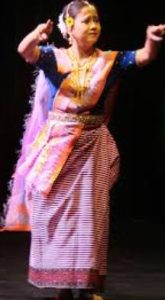
Image – Source
Phanek, though traditionally from Manipur, is popular among Assam’s Manipuri community. This skirt-like garment is worn with a blouse and sometimes with an additional wrap, and it holds significant cultural importance for Manipuri women in Assam.
Phanek features bright colours and unique patterns, symbolizing femininity and resilience. It is worn during cultural events and daily life, reflecting the identity and traditions of the Manipuri community.
With simple yet meaningful patterns, Phanek represents the unity of Northeast India’s cultural landscape.
| Aspect | Details |
| Material | Cotton and silk |
| Key Features | Skirt worn with a blouse |
| Occasions | Cultural festivals, daily wear |
| Special Motifs | Simple patterns, often stripes or tribal motifs |
| Significance | Represents Manipuri culture within Assam |
7. Karbi Traditional Dress
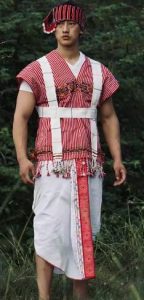
Image – Source
The Karbi tribe’s attire in Assam is characterized by bright colours and vibrant patterns. Karbi women wear a wraparound dress paired with a blouse, often complemented with an embroidered shawl. The attire uses traditional weaving techniques and showcases Karbi motifs.
Karbi traditional dress is a vibrant display of cultural pride and is often seen during festivals. The intricate embroidery on the shawl highlights the tribe’s craftsmanship, making it a unique aspect of Assamese tribal attire.
| Aspect | Details |
| Material | Cotton and wool |
| Key Features | Wraparound dress with a blouse and shawl |
| Occasions | Cultural events and daily wear |
| Special Motifs | Tribal designs and embroidery |
| Significance | Symbolizes the cultural identity of the Karbi tribe |
8. Traditional Rabha Costumes
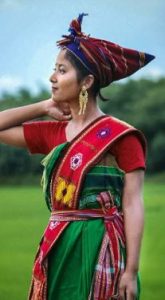
Image – Source
The Rabha community of Assam is known for its vibrant and unique traditional costumes, which reflect their rich culture and heritage. The Rabha costume is distinct, showcasing intricate handwoven fabrics and a blend of natural motifs in the designs.
The outfit typically includes a Kurti (upper garment) and Phulia (lower garment) for women, paired with a headgear and shawl. Men usually wear a Dhoti and Kurta.
Rabha costumes are made from locally sourced materials such as cotton, silk, and jute. The colour palette often features bold, earthy tones, with red, white, and black being prominent in the garments, symbolizing strength and prosperity. These costumes are worn on special occasions such as community festivals, marriages, and celebrations.
The Rabha tribe is particularly known for their intricate weaving techniques that feature traditional geometric patterns, often accompanied by symbolic motifs representing nature and community life.
| Aspect | Details |
| Material | Cotton, Silk, Jute |
| Key Features | Kurti, Phulia, Headgear, Shawl |
| Occasions | Weddings, Community festivals, Cultural celebrations |
| Special Motifs | Geometric designs, Nature-inspired motifs |
| Significance | Represents Rabha cultural identity and community heritage |
9. Dimasa Tribal Attire
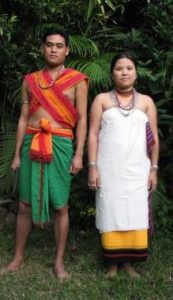
Image – Source
The Dimasa tribe, native to the northeastern part of India, has a traditional costume that speaks of their ancient customs and heritage. Women wear a lungi or sarong, which is a piece of cloth wrapped around the waist, paired with a blouse or choli.
Men typically wear a lungi and shirt, often coupled with a headband or turban. The colours of the Dimasa attire are bold and symbolic, often incorporating bright reds, yellows, and blues in the fabric.
The dimasa tribal dress is especially noted for its embroidery and beadwork, with motifs related to daily life, including animals, plants, and natural elements. These costumes are a reflection of the tribe’s close ties to nature and the environment.
| Aspect | Details |
| Material | Cotton, Silk, Handwoven fabrics |
| Key Features | Lungi, Blouse/Choli, Headband/Turban |
| Occasions | Festivals, Ceremonies, Rituals, Cultural events |
| Special Motifs | Beadwork, Embroidery depicting animals, plants, nature |
| Significance | Represents Dimasa tribal identity, community, and nature |
10. Traditional Assamese Jewellery: Japi, Gam Kharu, and Junbiri
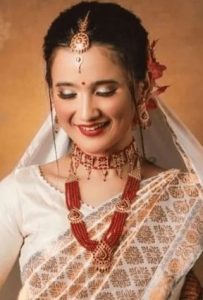
Image – Source
Assamese jewellery is an essential part of Assamese culture, known for its intricate designs and rich history. These pieces are often handcrafted using gold, silver, and brass, and are worn during special occasions like Bihu, weddings, and festivals.
The jewellery reflects Assam’s cultural vibrancy, with each piece symbolizing a specific cultural or spiritual significance.
- Japi – A traditional Assamese headgear, often worn during festivals or ceremonial occasions. It is made of bamboo and decorated with brass and gold. The Japi signifies the Assamese people’s respect for nature and symbolizes good luck and prosperity.
- Gam Kharu – This is a traditional Assamese bracelet, typically made of gold or brass. Worn by women, it holds cultural significance, representing strength and beauty. The intricate designs often feature floral motifs or symbols of fertility and growth.
- Junbiri – A traditional Assamese necklace made from gold or silver, typically worn by women during weddings and festive occasions. The necklace often features intricate patterns and is designed to complement the Mekhela Chador, adding a finishing touch to the traditional attire.
| Aspect | Details |
| Material | Gold, Silver, Brass, Bamboo |
| Key Features | Japi (headgear), Gam Kharu (bracelet), Junbiri (necklace) |
| Occasions | Bihu, Weddings, Festivals, Cultural Celebrations |
| Special Motifs | Floral patterns, Geometric designs, Nature-inspired motifs |
| Significance | Symbolizes prosperity, beauty, strength, and cultural heritage |
Conclusion
The traditional dresses of Assam are not only a testament to the region’s artistic excellence but also a celebration of its culture and heritage. With intricate weaving techniques and meaningful motifs, each garment tells a story of Assamese pride and history.
These top 10 dresses continue to be an integral part of Assamese life, symbolizing cultural identity, spirituality, and the connection to nature.
As Assamese traditional attire evolves, it remains a beloved element of the state’s rich cultural tapestry, beautifully blending the old and the new for generations to come.
FAQs
What are the key materials used in Assamese traditional dress?
Muga, Pat, and Eri silks are the primary materials used for crafting Assamese traditional attire.
When is traditional Assamese attire typically worn?
It is commonly worn during festivals, weddings, and cultural celebrations like Bihu.
What makes Assamese traditional dresses unique?
The intricate handwoven designs and nature-inspired motifs make Assamese garments stand out.
Are traditional Assamese dresses worn only by women?
No, both men and women wear traditional Assamese attire, with different garments for each gender.
What is the significance of the Bihu festival in Assamese dress?
During Bihu, traditional dress is worn to celebrate Assamese culture, prosperity, and new beginnings.
Can Assamese traditional dress be worn outside of cultural events?
Yes, modern versions of traditional attire are often worn for formal occasions and special events.

